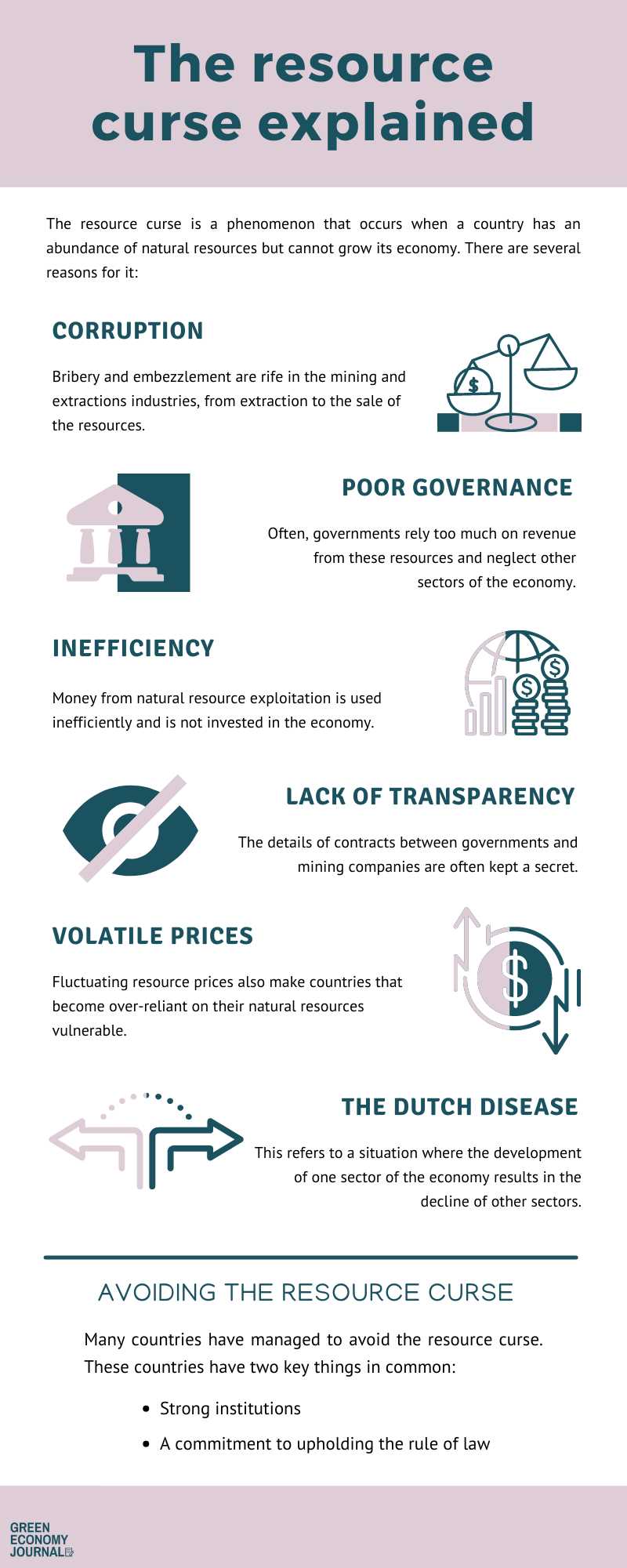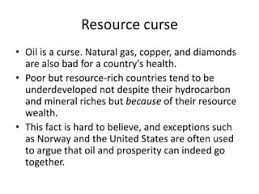What is the Resource Curse?
The resource curse occurs when a country’s economy becomes overly dependent on the extraction and export of natural resources. This reliance on a single sector can lead to various negative consequences, including economic instability, corruption, inequality, and political instability.
One of the main reasons behind the resource curse is the volatility of commodity prices. Countries that heavily rely on a single resource are vulnerable to fluctuations in global markets. When prices are high, these countries experience economic booms, but when prices fall, they face severe economic downturns.
Overview of the Resource Curse
The resource curse is a complex issue that affects both developed and developing countries. It is often observed in countries with weak institutions, lack of transparency, and poor governance. These factors contribute to the mismanagement and misallocation of resource revenues, leading to economic underperformance.
Additionally, the resource curse can lead to the crowding out of other sectors of the economy. When a country’s natural resource sector dominates the economy, it can hinder the development of other industries, such as manufacturing or agriculture. This lack of diversification makes the country more vulnerable to external shocks and reduces its overall economic resilience.
Examples of the Resource Curse

There are numerous examples of countries that have experienced the resource curse. One notable case is Nigeria, which is rich in oil reserves. Despite its vast oil wealth, Nigeria has struggled with widespread poverty, corruption, and political instability. The mismanagement of oil revenues has hindered the country’s economic development and perpetuated social inequality.
Another example is Venezuela, which possesses one of the largest oil reserves in the world. However, mismanagement, corruption, and overreliance on oil revenues have led to an economic crisis, hyperinflation, and social unrest in the country.
These examples highlight the detrimental effects of the resource curse and the importance of effective resource management and diversification strategies for countries rich in natural resources.
There are several factors that contribute to the resource curse. One of the main factors is the volatility of resource prices. Countries heavily dependent on a single resource are vulnerable to fluctuations in global commodity markets. When prices are high, these countries experience an economic boom, but when prices fall, they suffer from economic downturns.
Another factor is the mismanagement of resource revenues. Many resource-rich countries struggle with corruption, weak governance, and lack of transparency, which leads to the misallocation and embezzlement of funds. Instead of investing in infrastructure, education, and healthcare, the revenues are often squandered or used to enrich a small elite.
The resource curse also has negative effects on the environment and social dynamics. The extraction of natural resources often leads to environmental degradation, deforestation, and pollution. Additionally, the concentration of wealth in the hands of a few exacerbates income inequality and can lead to social unrest and conflict.
Resource Curse and Developing Countries
The resource curse is particularly prevalent in developing countries, where the lack of institutional capacity and weak governance systems make them more susceptible to its negative effects. These countries often lack the necessary infrastructure and human capital to effectively manage and diversify their economies.
Furthermore, the resource curse can hinder the development of other sectors of the economy. The abundance of natural resources creates a “Dutch disease” effect, where the focus on resource extraction crowds out other industries, such as manufacturing or agriculture. This over-reliance on a single sector makes the economy vulnerable to external shocks and decreases its resilience.
In order to mitigate the resource curse, developing countries need to implement effective policies and institutions. This includes improving transparency and accountability in the management of resource revenues, investing in education and skills development, diversifying the economy, and promoting sustainable resource extraction practices.
Resource Curse and Developed Countries
While the resource curse is more commonly associated with developing countries, it can also affect developed countries. However, the impact is often less severe due to their stronger institutional frameworks and diversified economies.
Developed countries can still face challenges related to the resource curse, such as environmental degradation and social inequality. However, their ability to effectively manage resource revenues and invest in alternative sectors helps mitigate these negative effects.
Overview of the Resource Curse
One of the main reasons why the resource curse occurs is the overreliance on a single resource or a small number of resources. This can lead to a lack of diversification in the economy, making it vulnerable to fluctuations in commodity prices. When the prices of these resources are high, the country may experience rapid economic growth. However, when prices fall, the economy can suffer a severe downturn.
Another factor that contributes to the resource curse is the mismanagement of resource revenues. In many cases, the revenues generated from the extraction and sale of natural resources are not used effectively to benefit the population. Corruption, lack of transparency, and poor governance can result in the misallocation of funds, leading to economic instability and inequality.
The resource curse can also have negative social and environmental impacts. The extraction of natural resources often leads to environmental degradation, including deforestation, pollution, and habitat destruction. Additionally, the concentration of wealth and power in the hands of a few can lead to social unrest, political instability, and even conflict.
However, it is important to note that not all resource-rich countries suffer from the resource curse. Some countries have been able to effectively manage their resources and use them as a catalyst for sustainable development. These countries have implemented policies to promote diversification, invest in education and infrastructure, and ensure that resource revenues are used for the benefit of the population as a whole.
Examples of the Resource Curse
Here are some examples of countries that have experienced the resource curse:
1. Nigeria
Nigeria is one of the largest oil-producing countries in the world, but it has struggled to translate its resource wealth into economic development. The country has been plagued by corruption, mismanagement, and political instability, which have hindered its ability to diversify its economy and invest in sectors other than oil. As a result, Nigeria has experienced high levels of poverty, inequality, and unemployment.
2. Venezuela

Venezuela is another country that has been severely affected by the resource curse. Despite having the largest oil reserves in the world, the country has experienced a deep economic crisis characterized by hyperinflation, shortages of basic goods, and a decline in living standards. The Venezuelan government’s heavy reliance on oil revenues and mismanagement of the oil industry have contributed to this crisis.
3. Democratic Republic of Congo
The Democratic Republic of Congo is rich in natural resources, including minerals such as copper, cobalt, and diamonds. However, the country has been plagued by conflict, corruption, and weak governance, which have hindered its ability to harness its resource wealth for the benefit of its population. Instead, the exploitation of minerals has fueled conflict and contributed to human rights abuses.
4. Angola
Angola is one of the largest oil producers in Africa, but it has struggled to diversify its economy and reduce its dependency on oil. The country has faced issues such as corruption, mismanagement, and a lack of transparency in the oil sector. As a result, the majority of the population has not benefited from the country’s oil wealth, and poverty levels remain high.
5. Equatorial Guinea
Equatorial Guinea is a small country in Central Africa that has experienced rapid economic growth due to its oil reserves. However, the wealth generated from oil has not been distributed equitably, and the majority of the population still lives in poverty. The country has also faced allegations of corruption and human rights abuses.
These examples highlight the challenges that countries rich in natural resources face in translating their resource wealth into sustainable economic development. The resource curse serves as a reminder of the importance of good governance, transparency, and diversification of the economy to avoid the negative effects of relying too heavily on a single resource.
STRATEGY & EDUCATION
Strategies to Address the Resource Curse
There are several strategies that can be implemented to mitigate the negative effects of the resource curse:
- Economic Diversification: One of the main strategies is to diversify the economy by investing in sectors other than the resource industry. This can help reduce the country’s dependence on the resource sector and create a more stable and sustainable economy.
- Investment in Infrastructure: Another important strategy is to invest in infrastructure development. This can help improve transportation, communication, and energy systems, which are essential for economic growth and development.
- Transparency and Accountability: Ensuring transparency and accountability in the management of natural resources is crucial. This can be achieved through the implementation of effective governance mechanisms, such as proper regulation, monitoring, and reporting.
- Education and Skill Development: Investing in education and skill development is essential to create a knowledgeable and skilled workforce. This can help diversify the economy and reduce the country’s dependence on the resource sector.
Education to Address the Resource Curse
Education plays a vital role in addressing the resource curse. It can help raise awareness about the negative consequences of the resource curse and empower individuals and communities to take action. Here are some key aspects of education to address the resource curse:
- Public Awareness Campaigns: Public awareness campaigns can be conducted to educate the general public about the resource curse and its implications. These campaigns can include workshops, seminars, and media campaigns.
- Curriculum Development: Integrating the topic of the resource curse into the curriculum can help educate students about the challenges and opportunities associated with resource-rich countries.
- Capacity Building Programs: Capacity building programs can be designed to provide individuals and communities with the necessary skills and knowledge to address the resource curse effectively. These programs can include training sessions, workshops, and mentoring programs.
- Research and Analysis: Encouraging research and analysis on the resource curse can help generate valuable insights and recommendations for policymakers and stakeholders.
By implementing these strategies and investing in education, countries can work towards mitigating the negative effects of the resource curse and creating a more sustainable and prosperous future.

Emily Bibb simplifies finance through bestselling books and articles, bridging complex concepts for everyday understanding. Engaging audiences via social media, she shares insights for financial success. Active in seminars and philanthropy, Bibb aims to create a more financially informed society, driven by her passion for empowering others.
